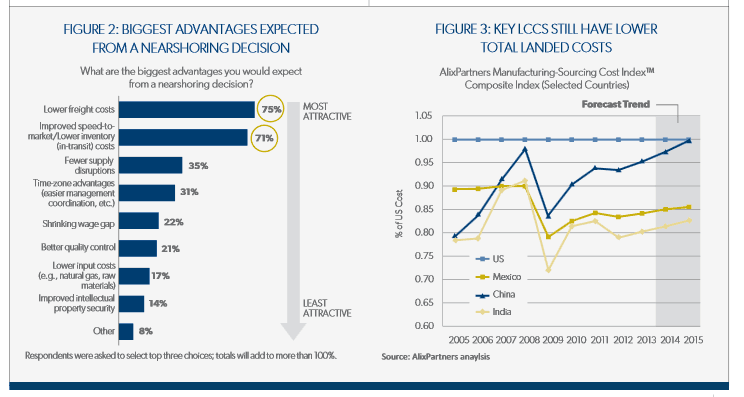From SCDigest's On-Target E-Magazine
- May 9, 2013 -
Supply Chain News: Yet Another Study Shows US Gaining Manufacturing Advantage
AlixPartners Research Finds US will Reach Cost Parity with China by 2015, Is Tied with Mexico as Location for Nearshoring, but Neither Trend Ensures Major Reshoring Move in the End
SCDigest Editorial Staff
Yet another in what has been a series of studies in recent years that show the US is indeed growing in manufacturing competiveness has just been released by the consultants at AlixPartners, and it also finds the US has been gaining on Mexico as a location source as well.
SCDigest Says: |
 |
Of course, growing cost equality and opinion survey results do not mean that the US will in fact see a manufacturing renaissance in the end. |
|
What Do You Say?
|
|
|
|
Over the past two years or so, studies from Boston Consulting, Accenture, MIT and others have found that the US is becoming increasingly cost competitive with China, more specifically with China's manufacturing centers on its East Coast, where wages have been rising rapidly. Several of these studies have also found growing interest by US manufacturers in bringing back at least some production to US soil, and/or not moving factory work that might have gone offshore before.
Some of these studies have in fact predicted a "manufacturing renaissance" from some of these changes. While there are many anecdotal stories of moves back to US soil by manufacturers, the evidence of such a renaissance has to date been hard to find in much of the data, especially trade statistics. However, Alix says that there has been an increase in the portion of US manufactured goods that are produced domestically. In 2005, 67.6% of the total manufactured goods consumed in the US were made domestically. As of 2011, that portion had risen to 71.9%.
The research by AlixPartners comes to some similar conclusions as some of the previous studies, estimating that the US will become cost competitive with China by 2015, similar to the predictions offered previously by Boston Consulting Group. (See New Study from Boston Consulting Finds China Manufacturing Cost Advantage Over US to Disappear by 2015.)
Alix said that for this research, took an in-depth look at three different product types: fabricated parts (machined or stamped parts as well as molded-plastic and precision medical equipment), assemblies (including complex electromechanical devices and auto-welded assemblies), and consumer products (including personal care products and packaging). It then compared total costs for production in the US to total landed costs from China, India and Mexico.
As shown in the right-hand side of the chart below, currently the comparable costs are about 5% lower from China, 15% lower in Mexico, and about 20% lower from India. But, the gap with China will have been closed by 2015 (largely by increases in China costs, especially labor rates and currency appreciation), while the gaps with India and China will have closed just a couple off percentage points. Alix notes that if ocean carriers can ever managed to get rates back up to more normal and sustainable levels, those rising shipper costs would also eat into the current cost gaps with China and India.

Source: AlixPartners
(Manufacturing Article Continued Below)
|